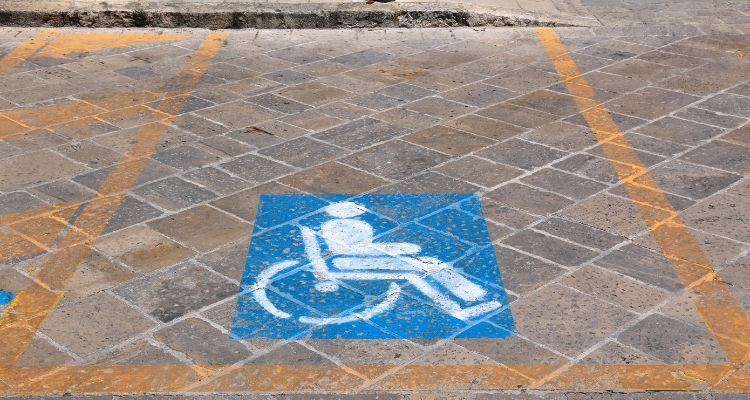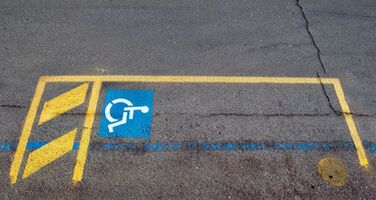
Discover the Benefits of Having a Handicap Placard in Alaska
Living with a disability can present many challenges, especially when it comes to mobility and transportation. In AK, with its often harsh and unpredictable weather conditions, getting from place to place can be particularly difficult for those with disabilities. However, for individuals who have limited mobility, a disability tag provides significant benefits that make accessing public spaces and services much easier. Disability tags allow holders to park in designated accessible parking spaces, typically located closer to building entrances, and offer other critical conveniences that help individuals maintain their independence.
This comprehensive guide explores the benefits of having a handicap placard in Alaska, how to apply for one, the rules governing its use, and the many ways in which this small but powerful tool can make life more manageable for individuals with disabilities.
What Is a Disability Tag?
Definition and Purpose
A disability tag (also known as a placard or permit) is a special parking permit issued by the Alaska Division of Motor Vehicles (DMV) that allows individuals with qualifying disabilities to park in designated accessible parking spaces. These spaces are often located closer to the entrances of buildings, and they provide extra room to accommodate vehicles with wheelchair lifts or other mobility aids.
Disability tags are essential for those with limited mobility because they reduce the physical burden of walking long distances in parking lots, especially in harsh weather conditions common in AK. They provide safer and more convenient access to public and private facilities, making daily activities such as shopping, attending appointments, or visiting recreational areas more accessible.
Types of Disability Tags in Alaska
In AK, there are two primary types of handicap permits available, depending on the duration and nature of the disability:
Permanent Disability Tag: Issued to individuals with permanent disabilities that are unlikely to improve over time. This tag is valid for five years and can be renewed before it expires. Permanent tags are blue in color.
Temporary Disability Tag: Issued to individuals with temporary disabilities, such as those recovering from surgery or injury. Temporary tags are valid for up to six months and can be renewed if necessary, with updated medical certification. Temporary tags are red in color.
In addition to tags, individuals with disabilities who own or lease a vehicle can apply for disability license plates, which provide the same parking privileges as tags but are permanently affixed to the vehicle.
How to Apply for a Handicap Placard in Alaska
Applying for a disability tag in AK is a straightforward process, but it does require medical certification from a licensed healthcare provider. Here’s what you need to know:
Eligibility Criteria for a Disability Tag
To qualify for a disability tag in AK, you must have a medical condition that limits your ability to walk or requires the use of mobility aids. The state's DMV outlines specific criteria for eligibility, including:
- Inability to walk 200 feet without stopping to rest.
- Use of portable oxygen.
- Severe cardiac conditions classified as Class III or IV by the American Heart Association.
- Severe lung disease.
- Dependence on mobility aids such as wheelchairs, walkers, or crutches.
- Legal blindness or severe visual impairment.
Your healthcare provider will need to certify that you meet these eligibility requirements before you can receive a disability tag.
Application Process Overview
To apply for a handicap placard in Alaska, follow these steps:
Download the Application Form: The Application for Disabled Parking Identification (Form 861) is available on the state's DMV website or can be picked up at a local DMV office.
Complete the Personal Information Section: Fill out your name, address, and other identifying information.
Obtain Medical Certification: A licensed HandicapMD healthcare provider must complete the medical certification portion of the form, confirming that you meet the eligibility criteria.
Submit the Application: Once the form is complete, submit it to the state's DMV in person or by mail. Be sure to include any necessary documentation and fees (if applicable).
Getting a Disability Tag Through HandicapMD.com
For a more convenient way to obtain medical certification, you can use HandicapMD.com, an online platform that simplifies the process of applying for a disability tag. Here’s how it works:
Visit HandicapMD.com: Start by visiting the HandicapMD.com website and completing a brief online questionnaire about your medical condition.
Consult with a Licensed Physician: HandicapMD.com will connect you with a licensed physician who will review your medical history and determine if you qualify for a disability tag. The physician will complete the necessary medical certification and send you the documents.
Submit Your Application: After receiving the certified documents from HandicapMD.com, you can submit your completed application to the state's DMV.
This online process eliminates the need for an in-person doctor’s visit, making it easier to get the medical certification you need to apply for a disability tag.
Required Documentation
When applying for a disability tag in AK, you will need:
- A completed Application for Disabled Parking Identification (Form 861).
- Medical certification from a licensed healthcare provider.
- Proof of identity, such as a driver’s license or state-issued ID card.
Temporary vs. Permanent Tags
Permanent Disability Pass: Issued to individuals with long-term or permanent disabilities and valid for five years.
Temporary Disability Pass: Issued for short-term disabilities and valid for up to six months. A new medical certification will be required if the disability persists beyond this period.
Renewing and Replacing Your Tag
Disability tags in AK are issued for five years for permanent disabilities and up to six months for temporary disabilities. It’s important to renew your tag before it expires to avoid losing access to handicap parking.
If your disability tag is lost, stolen, or damaged, you can request a replacement from the state's DMV by submitting the appropriate forms and providing proof of identity.
The Key Benefits of Having a Handicap Placard in Alaska
A handicap placard in AK provides a range of benefits, particularly given the unique challenges posed by the state’s climate and terrain. Here are the most important benefits:
1. Accessible Parking Spaces
One of the primary advantages of having a disability tag is the ability to park in designated accessible parking spaces. These spaces are usually located closer to the entrances of public buildings, shopping centers, medical facilities, and recreational areas, making it easier for individuals with disabilities to access these places without walking long distances.
In AK, where icy conditions and snow-covered walkways can pose serious risks, being able to park near an entrance significantly reduces the chance of slips, falls, and other accidents. Additionally, accessible parking spaces are often wider than standard spaces, providing extra room for wheelchair lifts, walkers, and other mobility devices.
2. Convenience and Safety in Harsh Weather Conditions
AK is known for its extreme weather conditions, especially during the winter months when snow, ice, and freezing temperatures are common. For individuals with disabilities, these conditions can make parking in standard spaces both inconvenient and dangerous. A disability tag allows you to park in spaces that are typically cleared of snow and ice more frequently, reducing the risk of injury.
By allowing you to park closer to building entrances, a disability tag also limits your exposure to the cold, wind, and precipitation, helping you avoid long walks through potentially hazardous parking lots in inclement weather.
3. Reduced Physical Strain
For individuals with disabilities, walking even short distances can cause significant physical strain, pain, or fatigue. A disability tag minimizes this burden by providing access to parking spaces that are closer to the entrances of the buildings you need to access.
Whether you’re visiting a doctor’s office, grocery store, or public venue, having a disability tag ensures that you won’t have to navigate long distances across parking lots, which can be especially taxing if you use a wheelchair, cane, walker, or other mobility aids.
4. Access to Public Facilities
In addition to private parking lots, disability tags provide access to public facilities such as parks, libraries, museums, and government buildings. Many public areas in AK have designated accessible parking spaces that are reserved for individuals with disabilities. This makes it easier for you to participate in community events, recreational activities, and other public services without the hassle of finding a suitable parking spot far from your destination.
5. Exemptions from Parking Fees in Some Areas
In some areas, having a disability tag may also provide exemptions from parking fees. While parking regulations vary by municipality, some cities in AK may offer free parking in metered spaces for individuals with disability tags, especially if they are unable to access the parking meter due to their disability.
It’s important to check with local authorities to see if this benefit applies in your area and what specific rules are in place regarding metered parking for individuals with disabilities.
6. Ease of Travel
A disability tag issued in AK is not only valid within the state but also recognized in all other U.S. states under the Americans with Disabilities Act (ADA). This means that you can use your tag to park in designated accessible spaces when traveling outside AK, making it easier for you to get around while on vacation or visiting other states.
Whether you’re driving through neighboring states or flying to a different part of the country, your disability tag ensures that you’ll have access to the same parking accommodations that you rely on at home.
7. Extended Parking Times
Some accessible parking spaces in AK allow for extended parking times. For individuals with disabilities, this means they don’t have to rush back to their vehicle and can attend medical appointments, shopping trips, or recreational outings at a comfortable pace without worrying about parking limitations. This benefit can be particularly advantageous in areas with strict time limits on parking.
8. Use of Free Public Transportation
While not all localities offer free public transportation based on disability status, certain areas in AK may provide reduced or free public transportation services for people with disabilities. In Anchorage, for instance, residents with disabilities can apply for discounted fares on public buses. This provides not only accessible parking but an added transportation alternative, enabling better mobility throughout the state.
9. Enhanced Access to Recreational Areas
AK is home to some of the most stunning parks and wildlife preserves in the world. The Alaska Department of Natural Resources (DNR) and other local agencies recognize the importance of making these areas accessible to everyone. A disability tag often provides easier access to visitor centers, lookout points, and trails, as well as accessible fishing spots, picnic areas, and other recreational facilities. This inclusivity ensures everyone can experience AK's natural wonders.
10. Convenience During Medical Appointments
Many Alaskans with disabilities require frequent medical appointments. A disability tag allows them to park closer to entrances at hospitals, clinics, and other healthcare facilities, reducing physical strain and facilitating quicker access to healthcare services. This benefit can ease the stress of navigating parking lots, particularly during AK's harsher winter months.
11. Easy Access to Essential Services
Obtaining groceries, medications, and other essentials can be a significant task for people with disabilities. A disability tag ensures Alaskans can access designated parking spaces at grocery stores, pharmacies, and shopping centers, reducing the time and effort needed to access these crucial services.
12. Priority Parking at Events and Community Functions
AK hosts numerous events, from state fairs to local markets and cultural festivals. Disability tags offer access to priority parking at such events, ensuring that people with disabilities can participate fully in community activities. Event organizers often set aside accessible spaces to ensure that Alaskans with disabilities can attend and enjoy these events without excessive walking or navigating crowded areas.
13. Rights and Protections Under the ADA
With a disability tag, individuals in AK benefit from ADA protections that prevent discrimination based on disability status. This includes the right to accessible parking spaces and public accommodations. The tag serves as a visible indicator of these rights, which helps deter parking violations and promotes respect for accessible spaces.
How to Use Your Disability Tag Correctly
To make the most of your disability tag and avoid fines or penalties, it’s essential to follow the rules governing its proper use. Here are some important tips to keep in mind:
Displaying Your Tag Properly
In AK, a disability tag must be hung from the rearview mirror of your vehicle whenever you are parked in an accessible parking space. The front of the tag, which displays the expiration date and permit number, must be facing outward so that it is clearly visible to parking enforcement officers.
Important: You must remove the tag while driving. Leaving the tag hanging from the rearview mirror while your vehicle is in motion can obstruct your view and is considered a traffic violation.
Following Parking Rules and Avoiding Fines
While a disability tag grants access to designated accessible parking spaces, it does not exempt you from following other parking regulations. Here are a few things to remember:
Park only in designated accessible spaces: Use your tag only in parking spots marked with the international symbol of accessibility (the blue wheelchair symbol). Do not park in other restricted areas, such as fire lanes or spaces reserved for emergency vehicles.
Do not allow others to use your tag: The disability tag is issued to the individual with the qualifying disability and can only be used when that person is either driving or a passenger in the vehicle. Allowing someone else to use your tag without you present is illegal and can result in fines or revocation of the tag.
Renew your tag on time: Be sure to renew your disability tag before it expires to avoid losing your parking privileges. Using an expired tag can result in parking tickets and the inability to park in accessible spaces legally.
Frequently Asked Questions (FAQs)
1. How long is a disability tag valid in AK?
- Permanent disability passes are valid for five years and must be renewed before they expire.
- Temporary disability passes are valid for up to six months and can be renewed with updated medical certification if necessary.
2. Can I use my AK disability tag in other states?
Yes, disability tags issued in AK are recognized in all other U.S. states under the Americans with Disabilities Act (ADA). You can use your tag to park in designated accessible spaces while traveling, but be sure to check local parking regulations regarding time limits and fees.
3. What should I do if my disability tag is lost or stolen?
If your disability tag is lost or stolen, you can request a replacement by submitting a new application to the Alaska DMV, along with proof of identity. There may be a small fee for issuing a replacement tag.
4. Can someone else use my disability tag?
No. A disability tag is issued to the individual with the qualifying disability and can only be used when that person is present in the vehicle. Allowing someone else to use your tag without you being there is illegal and can result in fines or the revocation of your tag.
5. How do I renew my disability tag in AK?
To renew a permanent disability tag, submit a renewal application to the state's DMV before your tag expires. No new medical certification is required for renewal unless your condition has changed. For temporary tags, you will need updated medical certification if your condition persists.
Conclusion
Having a handicap placard in Alaska offers significant benefits, from accessible parking and increased convenience to exemptions from parking fees in some areas. For individuals with mobility impairments, a disability tag can make daily activities more manageable and help maintain independence.
Whether you’re applying for a disability tag for the first time or need to renew your existing tag, understanding the application process, proper usage, and the benefits associated with your disability tag will ensure that you get the most out of this vital tool. If you’re looking for a streamlined way to obtain medical certification, HandicapMD.com provides a convenient online solution to help you get your disability tag quickly and easily.
.png)






